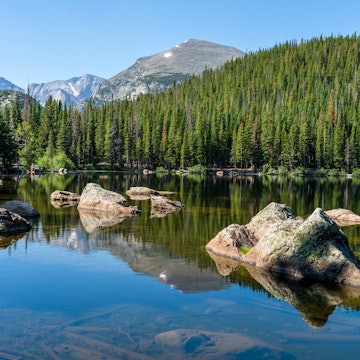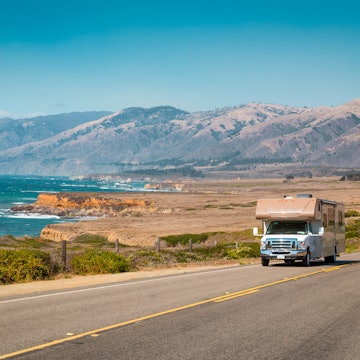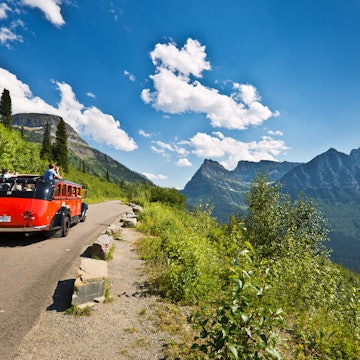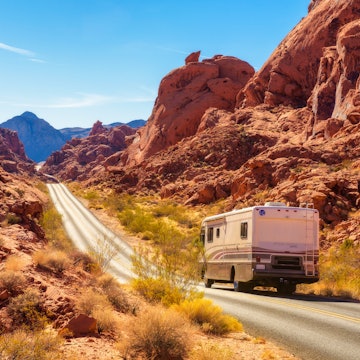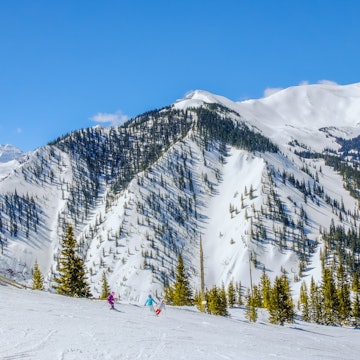

Rocky Mountain National Park is a wonderland of classic Colorado scenery. Colin D Young/Shutterstock
Lace up your hiking boots and step into the untrammeled wilderness of Rocky Mountain National Park, Colorado’s crown jewel. A trip through the park will take you from alpine meadows favored by herds of grazing elk and deer, up through the forests of ponderosa and spruce, before topping out on the windswept tundra.
Here, where the earth meets the sky, the landscape contains galaxies of ephemeral summer wildflowers, and the silhouettes of sculpted peaks serve as a dramatic reminder of the last ice age. As you ford frozen streams, puff up snow-dusted mountain-sides and pass beneath groves of quaking aspens fringed with fall gold, you’ll feel the natural vibes of Colorado.
Like many national parks, Rocky Mountain National Park can be mobbed during the summer season. But leave the main trailheads behind and you’ll quickly find your own patch of solitude, so long as you’re willing to share it with the wildlife. It’s one of the state’s best adventures.
If that has piqued your interest, learn more with this guide for first-time visitors to Rocky Mountain National Park.
When should I go to Rocky Mountain National Park?
The weather will have a big impact on when you visit. With the right equipment, it’s possible to visit year-round, but conditions can be harsh from mid-October to mid-April, particularly at higher elevations. Winter weekdays are the quietest time of the year in the park, and this is a good time for snowshoeing and spotting wildlife, as animals come out into the open to search for food.
The spring sees heavy snowfall give way to muddy conditions on the hiking trails, making this a quieter time for visitors and a good time for cheap accommodation deals. From May to October, the park’s timed reservation system comes into play, and you’ll need to book a permit to visit. Trails open from May and the park gets very busy from June to September, with peak prices (and heavy demand) at accommodations.
Beware of ticks from May to October, taking precautions to avoid bites. Electrical thunderstorms can arrive in the afternoon from July to August but mornings are usually clear. September sees the arrival of fall color, making this a great time for leaf-peeping – but you’ll need to be cautious of elk at this time during their annual rut.
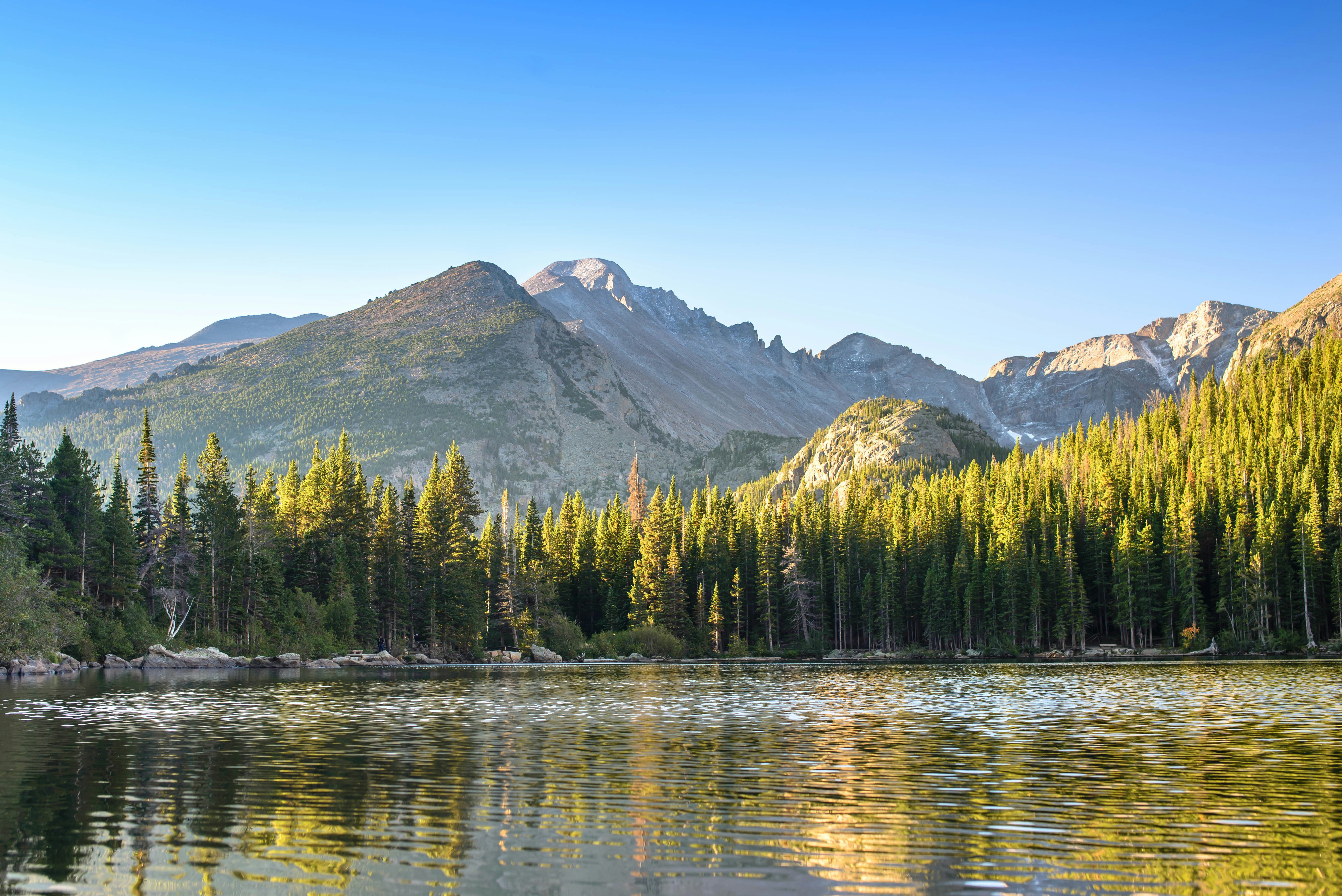
How much time should I spend in Rocky Mountain National Park?
How long you spend in Rocky Mountain National Park will depend on what you want to do when you get here. If you just want to dip in and see the highlights (perhaps taking a day-hike from either the Bear Lake or Glacier Gorge Junction trailheads), then a couple of days may be sufficient. For more-serious adventures deeper inside the park, consider staying for a week or more.
Is it easy to get into and around Rocky Mountain National Park?
The town of Estes Park – the gateway to Rocky Mountain National Park – is roughly one hour from Boulder and 90 minutes from Denver by car, following Hwy 36. Scenic Hwy 7 (also known as the Peak to Peak Hwy) also runs here from Nederland, passing the park’s southern entrances.
Coming from Fort Collins and I-25, you can access the park via Hwy 34, which continues through the park and on to Grand Lake, which serves as the national park’s western entrance and has its own cluster of amenities and accommodation options.
A shuttle bus service runs from Estes Park to the Bear Lake corridor, but to see the rest of the park, you’ll need a car. If you’re arriving by air, the Estes Park Shuttle can transport you from Denver International Airport to Estes Park; the round trip costs $135.
Do I need to make a reservation to visit Rocky Mountains National Park?
As well as paying the park entry fee (or having a national park pass), you must reserve a timed entry slot between late May and mid-October; to visit the Bear Lake Corridor between 5am and 6pm, you’ll need a “timed entry plus” reservation. There’s a nominal $2 fee on top of the usual park entry fees.
Reservations for timed entry should be made on Recreation.gov on the first day of the month prior to your entry. If you miss out on an advance booking, last-minute reservations go on sale at 7pm for entry the following day.

What are the facilities like in Rocky Mountain National Park?
For visitors to Rocky Mountain National Park, all roads lead to the small gateway town of Estes Park. If you don’t plan on staying in self-catering accommodation outside the park or setting up a camping stove at one of the park campgrounds, the chances are you’ll be spending the night here – or, at the very least, stopping for dinner.
Estes Park is a hodgepodge of t-shirt shops and ice-cream parlors, sidewalks crowded with tourists and streets jammed with RVs. But when the sun reflects just right off Lake Estes, or you spend an afternoon with a lazy coffee on the riverwalk, you might just find your own slice of Zen.
Estes promises every convenience to travelers – gear rental, guided tours, upscale hotels, fine dining and even a kids’ adventure park and via ferrata routes. There’s also the Estes Park Museum, which has a commendable rotation of exhibits on local culture and history.
Yet in the grand scheme of things, you probably won’t be spending much time here, outside of eating breakfast and dinner and catching some Zs. The town of Grand Lake at the park’s western entrance offers similar facilities on a smaller scale.
Where should I stay in Rocky Mountain National Park?
The most popular option if you want to immerse yourself fully in nature is a stay at one of the national park campsites at Moraine Park, Glacier Basin, Aspenglen, Longs Peak and Timber Creek. The Longs Peak Campground is a first-come, no-reservations site, open to tents only from July to early September.
Wilderness camping is also possible at designated sites, though all backcountry campers must have a wilderness permit and dash-tag (reserve online at Recreation.gov) and a bear canister. Reservations open March 1, and many dates sell out almost immediately.
While there is no other accommodation inside the national park, you’ll find plenty of options nearby in Estes Park and Grand Lake, from comfortable lodge-style hotels to the elegant Stanley Hotel (inspiration for Stephen King’s The Shining) and the YMCA of the Rockies, as well as Airbnbs for rent in the surrounding area. In summer, all accommodations should be reserved well in advance.
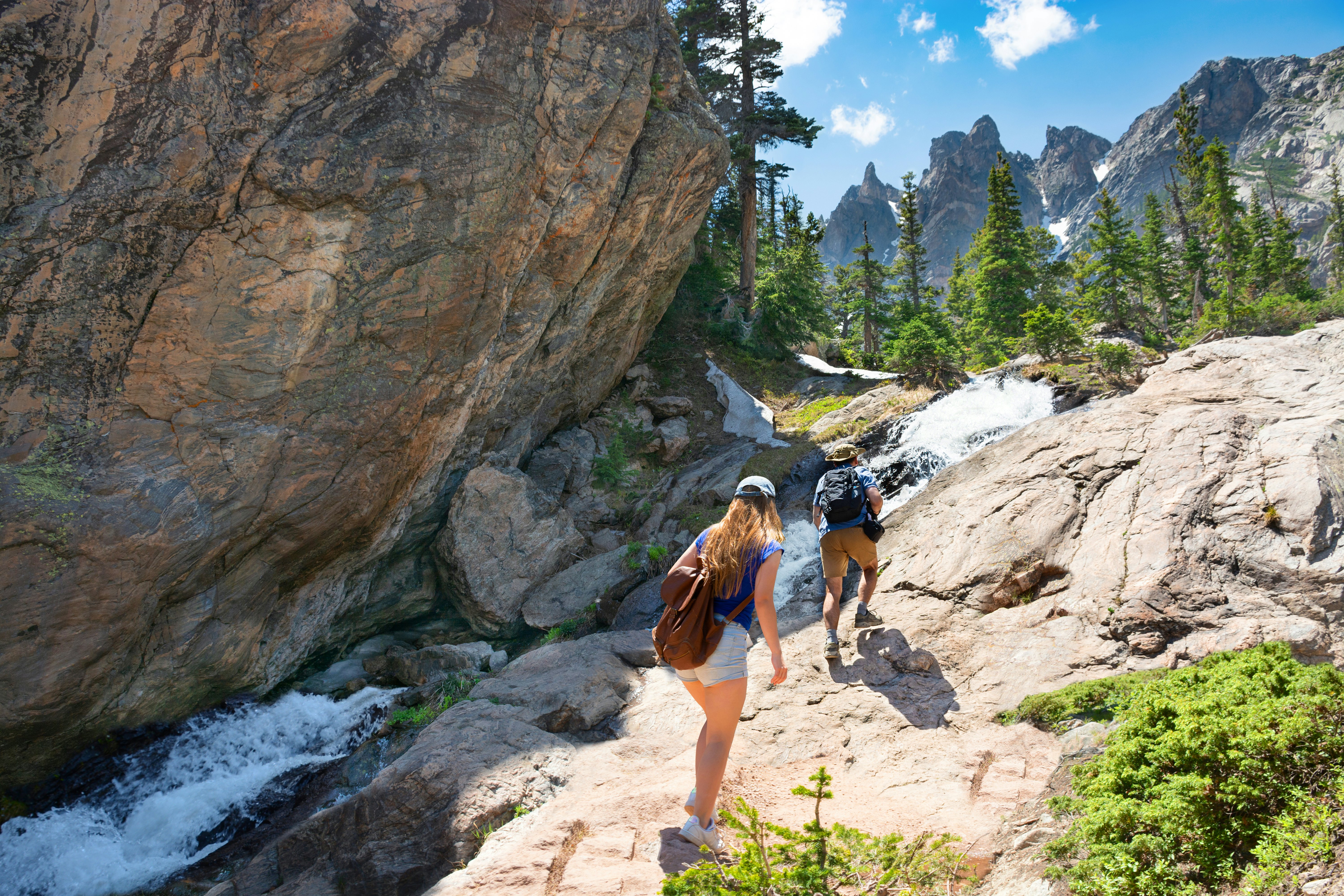
Top things to do in Rocky Mountain National Park
There’s loads to do in Rocky Mountain National Park, from short summer hikes to snowshoeing and wildlife spotting.
Take day a day hike at Bear Lake
The Bear Lake and Glacier Gorge Junction trailheads are the most popular destinations in the park for hikers. On a day-hike starting from either point, you’ll be able to take in the dramatic glacial valleys and hulking granite summits that make Rocky Mountain such a special place to explore. However, be aware that most high-country trails are snowbound until June.
Hikes range from easy jaunts to Alberta Falls (1.6 miles) or Dream Lake (2.2 miles) and Emerald Lake (3.6 miles) to more-challenging excursions that follow the glacial valleys up to their origins. Mills Lake (5.6 miles) is a good choice, as is the Loch (6.2 miles). And while 12,324ft Flattop Mountain (8.8 miles) may not be the park’s highest summit, there’s no denying its magnetic pull.
Note that you'll need a special timed entry reservation to drive into the Bear Lake Corridor area between 5am and 6pm, and these sell out faster than Taylor Swift concerts. There are a few workarounds, however. One option is to come on foot, catching a shuttle from Estes Park to the Bear Lake Park and Ride (reservations required) and then transferring to the in-park shuttle.
Another possibility is to reserve a campsite at Moraine Park, Glacier Basin or Aspenglen Campgrounds. Finally, if you have a backcountry camping permit in the Bear Lake area, this will also grant you access.
Go wildlife watching
The park is home to some 800 elk, 350 bighorn sheep, 60 moose, 20 to 30 bears, an unknown number of mountain lions and countless mule deer – and those are just the big guys. Smaller critters include beavers, marmots, pikas, porcupines, otters, foxes, coyotes and some 270 species of birds.
While you probably won’t spot the more elusive animals, if you pay attention, you’ll likely see or hear traces of their passage. Good places to look for wildlife include Moraine Park, Beaver Meadows, Sheep Lakes, the Trail Ridge Road, and marshy areas in the Kawuneeche Valley.
You don’t want a 1000lb bull elk with a massive rack of antlers trampling you, so follow the rangers’ guidelines and stay at least 75ft away from larger wildlife, or further from moose and bears. And please, don’t feed anything, no matter how cute it looks!
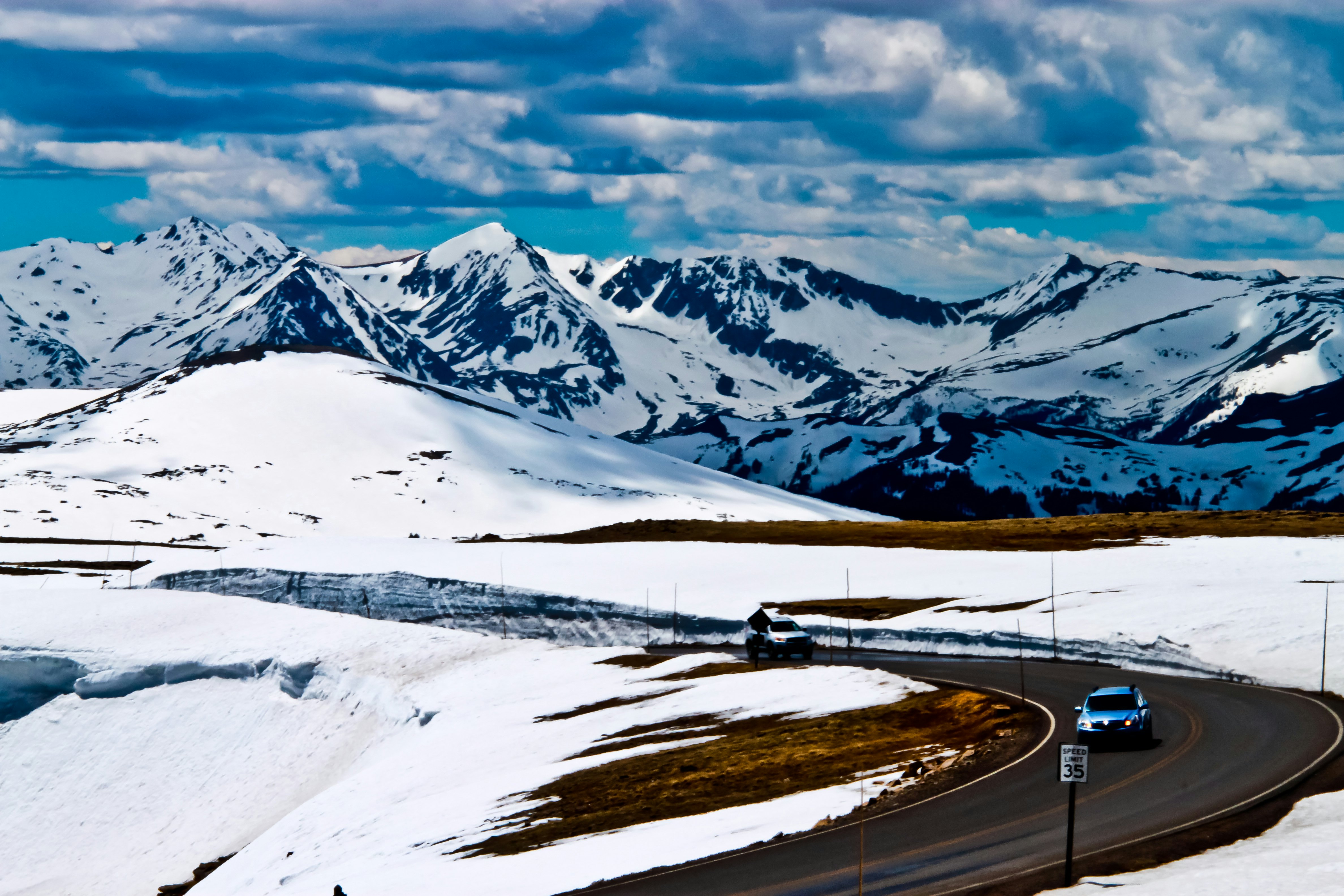
Take a scenic drive
The highest continuous paved highway in North America, the Trail Ridge Road – open from June through mid-October – completes a remarkable 4000ft climb, offering visitors the chance to experience the Rockies’ high alpine tundra, complete with bighorn sheep, whistling marmots and eye-popping panoramas in all directions.
You can start at either the east or west entrance of the park, and stop off along the route for high-altitude hikes – or simply content yourself with a dozen superlative-worthy vista points. Allow half a day to explore, and be prepared for chilly temperatures, intense sun and sudden thunderstorms. Watch for symptoms of altitude sickness, and always stay hydrated.
Time your visit for July, and you’ll be in the tundra when the meadows light up with a rainbow of wildflowers. Among the can’t-miss sights here are the Alpine Visitor Center at 11,796ft, which looks out over a hazy expanse of 400 sq miles, and the info-packed Tundra Communities Trail.
For another rewarding drive, the Old Fall River Road offers motorists a graveled, slow-paced (15mph max) route to the park’s high country. A 1920 original, this historic road is narrow, one-way, and a bit hair-raising at times.
The road begins at Horseshoe Park, a short distance west of the Fall River Entrance, and winds 11 miles up to the Alpine Visitor Center at Fall River Pass. From there, you can head southwest on the Trail Ridge Road and follow it to Grand Lake on the west side of the park, or loop back to Estes Park.
Climb Longs Peak
Iconic in every way, Longs Peak (14,259ft) is the pinnacle of Rocky Mountain National Park and one of Colorado’s classic climbs. Longs is most often scaled via the exhilarating and exhausting Keyhole Route (a 15-mile round trip), consisting of narrow traverses, vertiginous cliff faces and heart-pounding scrambles up polished slabs of rock.
You should acclimatize before taking this on – and it’s imperative to keep an eye on the weather at all times. Statistically, this is the deadliest hike in the park; the golden rule is to be off the summit by noon because of the risk of lightning strikes. Either start the climb by 2am or 3am, or secure a wilderness permit to camp for the night at the Boulder Field, just below the Keyhole.
You don’t actually have to reach the summit to experience Longs. Chasm Lake, located at the foot of the Diamond – the mountain's legendary east face – is one of the park’s best hikes (8.4 miles round trip), and it features all the spectacular scenery without the risk and effort of the summit ascent.

Go snowshoeing in winter
Whether you’re wearing skis, snowshoes or just plain old snow boots, there’s something particularly inspiring about exploring Rocky Mountain after fresh snowfall. Unlike in Colorado’s crowded ski resorts, visitor numbers plummet in winter, so you may have the wilds almost to yourself.
One of the easiest ways to get out into the snowy landscape is to strap on a pair of snowshoes, which will get you along most trails in the national park. National park rangers often lead guided walks on winter weekends. Another popular winter activity is cross-country skiing. For the more adventurous, there’s ice climbing – contact the Colorado Mountain School for guided trips and courses.
Warm-weather activities include walking to scenic waterfalls, cycling along paved roads and the Old Fall River Road, rock climbing on the granite outcrops of Lumpy Ridge (again, contact the Colorado Mountain School), llama treks, and horse-riding excursions lasting from two hours up to a full day.
How much money do I need for Rocky Mountain National Park?
Your biggest cost on a visit to Rocky Mountain National Park will be for accommodation. If you’re looking to cut costs, staying at national park campsites can cost as little as $26 per person, but you’ll need to make reservations well in advance to secure a spot.
Staying in lodges, hotels and other accommodations around the park will push up your costs considerably. Eating at restaurants in Estes Park or Green Lake can also be expensive. Airbnb has properties for rent in the area where you can self-cater, reducing your costs.
Also budget for the park entry fees and permits – which you’ll need to reserve in advance from May to October. A standard day-pass starts at $30 for a vehicle and passengers, while those entering on foot or by bike pay from $15 per person. Passes covering seven consecutive days are not much more expensive, costing from $35 per vehicle or $20 if you’re on foot or riding a bicycle. For a timed entry reservation, you’ll pay an additional $2 fee.
Other costs to consider include:
Night at a lodge or hotel: from $100
Organized day hike: from $180 per person
Restaurant meal: from $30 per person
Pint of craft beer: from $7
Bear Lake Shuttle Bus: free
This article was adapted from Lonely Planet’s Colorado guidebook, published in August 2025.









